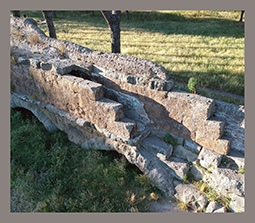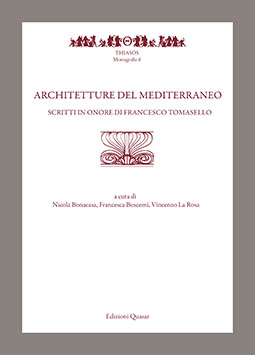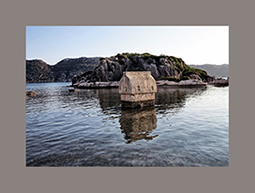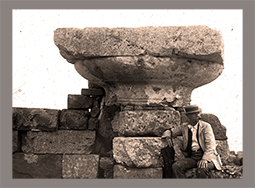In solo provinciali
Architecture in Roman provinces, from Augustus to the Severan Emperors,
between local inertias and Romanization
Thiasos is an online open access journal concerning archaeology and ancient architecture (www.thiasos.eu). The Italian National Agency for the Evaluation of Universities and Research Institutes (ANVUR) has rated it as class A journal – i.e., the highest ranking-class, according to the evaluation system introduced in Italy for not bibliometric research fields – for the scientific sectors CUN 10/A1 (Archaeology) and 08/E2 (History of Architecture and Restoration).
The Director-in-Chief, the members of the Directorial Committee, and the Editorial Board are pleased to announce the current call for papers for the next issue of the journal, no. 8, 2019, about the aforementioned topic, “Architecture in Roman provinces, from Augustus to the Severan Emperors, between local inertias and Romanization”.
Roman provincial architecture represents a privileged field for analysing the relations between official architectural models/trends and their local applications or, rather, interpretations. Actually, such relationship is multifaceted and variegated, depending on the ways how the considered entity – i.e., one building, its architectural city context or the belonging region/cultural area – interacts, at different scales, with the relevant architectural archetypes, then locally used, and their significance.
Furthermore, different variable factors do affect both the established connections between entities and their consequent results. They act on all the three Vitruvian virtues of architecture – firmitas, utilitas, and venustas – thus multiplying the potential variations.
The stylistic/typological sorting out of architectural members and their decoration has been traditionally adopted for the study of architectural ornament, providing scholars with important arguments. Nevertheless, it’s now acknowledged it might also bring to schematic, like-frozen categories, indeed sometimes quite far from their historic background. More recently, different research approaches have sought to correct such method in analysing ancient architecture, by successfully moving the scale-needle in favour of more properly building aspects: among them, employed materials and especially marbles, buildings’ realization costs, organization and management of quarries and building yards as well. Even providing a wider knowledge about building processes, they still deal with isolated topics, without considering the architectural organism as a whole. Thus, the political/religious significance expressed by carved architectural ornaments is complemented by building issues and not substituted by them, as well as it is by other supplementary aspects – i.e., the relation between plans and elevations, materials and workshops, patrons and realization costs, functions and local building traditions. Among these topics, local inertias do stand particularly out: depending on the focused geographic area of the Mediterranean, they may have autochthonous, Phoenician-Punic or Greek-Hellenistic origins, deeply affecting the building activity there.
Thus, the purpose is bringing to light the degree of influence of building local traditions in provincial regions and cities on the either imposed or spontaneous adoption of official models. The analysis can focus on specific aspects, but resulting from a wider, global perspective. Leaving aside now overpassed theoretical contrapositions (centre/periphery of the Roman empire, Romanization/resistance, …), the dialectical interconnectedness between established architectural patterns and their local adaptation is rather to be emphasized. The original results of provincial architecture – more or less fitted to architectural trends in Rome, more or less influenced by autochthonous traditions, more or less connected with the persistence of local inertias – will be, thus, consequently explained. Therefore, the current editorial initiative aims to provide the international scientific community with updated data about the most recent researches on architecture in Roman provinces, through a collective, hitherto absent, volume comparing different provincial regions, their monuments, their architectural peculiarities and traditions, their ways of interactions with established architectural canons.
Three thematic sections are foreseen. Proposals should fit into one of them:
- The elaboration of the architectural models: Rome and Italy.
- Western provinces.
- Eastern provinces.
The focused chronological period spans from the Augustan to the Severan age. About the first thematic section, concerning Rome and Italy, it also includes Late Republic.
Scholars willing to participate are welcome to submit an abstract in Italian or English, of no more than 1000 characters, along with its title and five keywords. Proposals are to be sent by the 31st of January 2019 to the following email address: call2019@thiasos.eu. The submitted file must also include the contributors’ affiliation, if any, and their emails, where all the communications about the current initiative will be addressed.
The Director and the Directorial Committee of the journal will assess the submitted proposals on the basis of their relevance and coherence with the aforementioned topics. Contributors will receive notifications about the acceptance of their proposals by the 15th of February 2019. Complete manuscripts will have to be submitted by the 31st of May 2019. Papers cannot exceed 35.000 characters (spaces included) for the main text and the related footnotes (bibliography and figure captions are excluded); they can be written in Italian or English, following the publication guidelines of the journal. Up to 15 b/w or greyscale illustrations can be foreseen.
Submitted papers will be peer-reviewed. Authors will eventually correct or modify their manuscripts according to peer-reviews by September 2019, in order to facilitate the publication process, which will be achieved by the end of the same year.
Essays will be collected within a special thematic supplementary issue of Thiasos, which is in any case part of the journal (about Supplementa to Thiasos, cf. http://www.thiasos.eu/en/about/). It will be published online in electronic version; if possible, also a paper edition might be issued by the publishing house of the journal, Quasar.
For more information or further inquiries, please contact the editors: call2019@thiasos.eu.
Download the Call for paper as .pdf: In solo provinciali
Reminder about the publication schedule
31st of January 2019 Proposal submission, indicating the relevant thematic section.
15th of February 2019 Notification to contributors about the acceptance of the submitted proposals.
31st of May 2019 Manuscript submission by the authors, for peer-reviewing.
30th of September 2019 Definitive submission of the papers, modified or corrected according to peer-reviews, by the authors.
31st of December 2019 Volume publication, as Supplementum to Thiasos, issue no. 8, 2019.
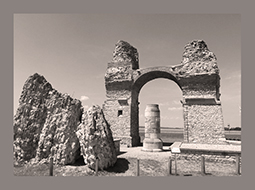 The paper discusses the hydraulic engineering and water management of the civil town of Carnuntum (Roman province of Pannonia – Austria). The actual state of research, which is primarily based on excavation results, is presented. Geophysical prospection data, collected in the course of the ‘ArchPro Carnuntum’ project, is used for additional analyses. Various anomalies point to building structures related to the provision of fresh water (a potential well and fountain and water conduits), the management of wastewater (sewers) and buildings that are interpreted as bath complexes (thermae) and a fuller´s workshop (fullonica).
The paper discusses the hydraulic engineering and water management of the civil town of Carnuntum (Roman province of Pannonia – Austria). The actual state of research, which is primarily based on excavation results, is presented. Geophysical prospection data, collected in the course of the ‘ArchPro Carnuntum’ project, is used for additional analyses. Various anomalies point to building structures related to the provision of fresh water (a potential well and fountain and water conduits), the management of wastewater (sewers) and buildings that are interpreted as bath complexes (thermae) and a fuller´s workshop (fullonica).
